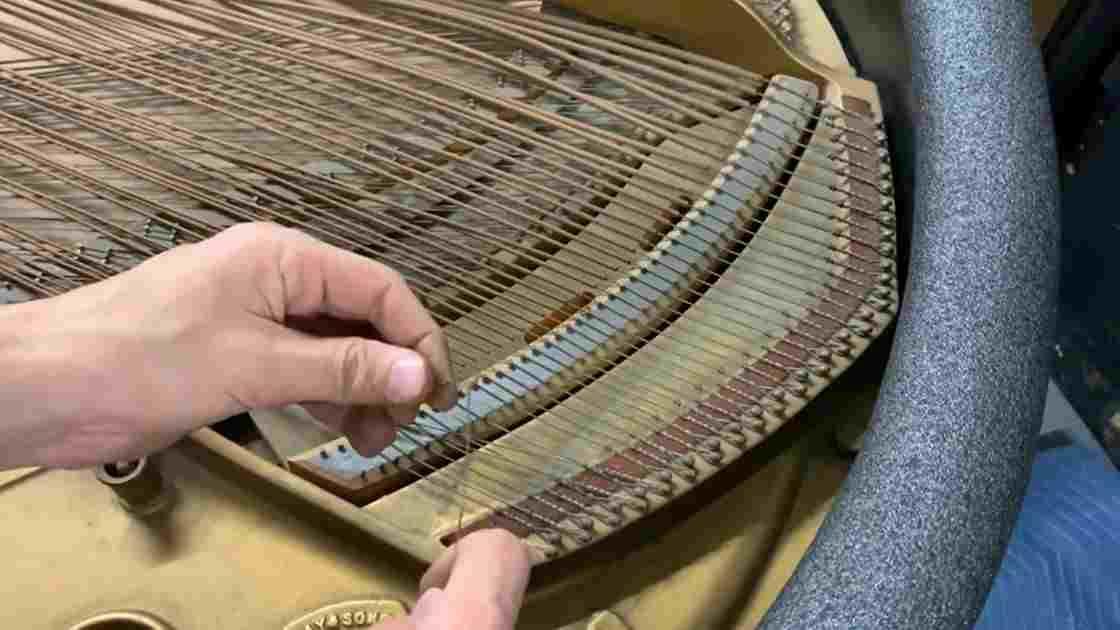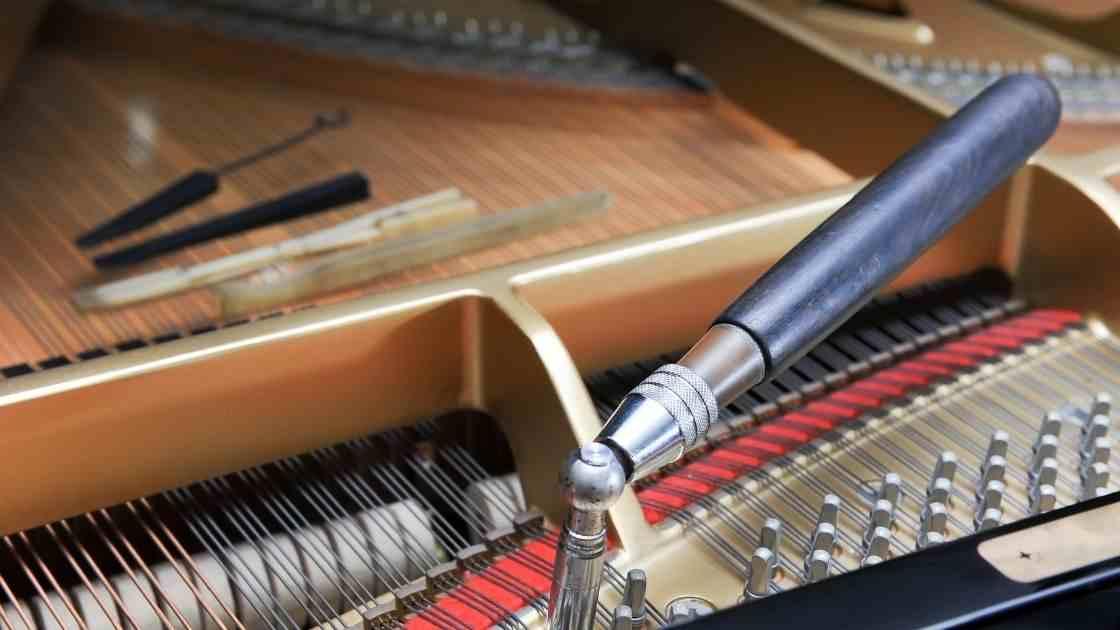Restring a piano is not a small effort. An 88-key full-size piano has about 230 strings and over ten thousand parts. The cost to restring a piano can be over $10,000 depending on the piano’s style and overall condition.
If an upright piano is in relatively good condition and needs only to be restrung, it may take 20 to 25 hours and about $2000; a grand piano in a similar condition may cost about $3000. Since we are talking about old pianos, it is more likely there will be additional repairs required. Hence the cost goes up.
Let’s take a detailed look at what it entails to restring a piano.
Cost of Restring a Piano
Many factors contribute to the cost of restringing a piano. However, it is boiled down to material and labor costs.
A complete set of piano strings costs about $500~$600, depending on your selected strings. The strings for the treble section are plain wire, but the bass section strings are wound strings that have strings wrapped around the plain wire. You may choose the generic replacement bass string or custom-made bass strings, which naturally cost more.
Cost Impacting Factors
In terms of labor costs, there are several impacting factors:
- Piano styles: upright, baby grand, or grand piano
- Technician qualification and experience: is he/she a registered piano technician at Piano Technicians Guild?
- Going rates in your area
- Additional repair required
- String replacement for the whole piano or just a section: normally bass strings wear out faster than treble strings.
- Type of strings: generic vs. custom-made
- Piano moving cost: does the piano need to be moved to the technician’s studio or repair shop?
Preparations Before Restring

Since piano restrings are a significant undertaking, they could cost you a lot of energy, time, and money. Therefore, it is wise to do an evaluation first to determine if you want to restring or not.
Usually, restring a piano involves much more than replacing the strings. During the preparation stage, the technician will evaluate the condition of your piano. Here are a few main elements they’ll check:
- Any string runs over the bridge
- Any cracks in the bridges
- Gaps between the bridge and the top of the soundboard
- Soundboard condition
- Replacing string felts and damper felts
- Need of regilding the plate (the cast iron frame)
- Pinblock state
- Hammers and dampers functions
If your piano needs repairs beyond the restring, the cost will increase depending on the repairing elements. Many of the above-listed elements are more complicated to repair than restring. For example, repairing a soundboard may take several weeks.
The Piano Restring Process
You may still wonder why the cost of restringing a piano is so high. Let’s review the significant steps involved in restring a piano.
Prep Works
Besides evaluating the piano’s condition to decide the piano restoration scope, including restringing and repairs, the piano technician prepares to make a good record of the string sizes, such as the diameter and the tuning pin size.
The record-keeping system is used to make good records of measurements so that the technician will know what to do when putting the piano back together. It could be as simple as a sheet of paper to record the size of each string, but it would make all the difference when determining the new string and tuning pin sizes.
When you look at the strings, you might think they look the same size; however, there are many different sizes. On average, a piano could have about ten different sizes of treble wire plus the bass strings. Hence, making an excellent string-size chart is truly important.
It is worth noting that the piano technicians use some special tools to remove the wires and tuning pins.
Process of Removing the Strings
In most pianos, many strings are wrapped around. They start at the tuning pin that comes up and runs over the bridge, wraps around a hitch pin, and then come down to the next tuning pin. This is what most of the treble strings are. On the other hand, most of the bass strings are tied, which means they start at the tuning pin and are tied at the other end.
On rare occasions, pianos have all strings tied at the end, including treble wires. In these cases, the technician has to make a loop for each string to be tied at the hitch pin. This process takes much more time and effort, but it is doable.
Release the String Tension Evenly
When removing the strings, it is not a good idea to start at the top and take one string off at a time because there is a lot of pressure from the strings on the plate. Removing the strings one by one will destabilize the pressure on the plate and cause damage. Sometimes, it is even dangerous.
Typically, the technician will loosen the tension on all the bottom strings of each note, then do it for all the top strings, and lastly, go back and through to do the middle strings. (Note: most of the piano notes have three strings.) This process gradually lets the string tension off the plate, equalizing the tension and avoiding the situation that one section loosened and the rest of the piano is still under tension.
This loosening process will be repeated several times until all the tensions are off the strings.
Removing the Treble Strings
Once all the string tensions are off, the next step is to take the string off by sniping it at the tuning pin end.
The technician measures the wires and records them, only recording one string for every note since all three strings of each note are the same diameter. Making a string size chart for each note helps to know what size wire is needed to replace them.
This process is mostly the same as on a grand piano vs. an upright piano. On a grand piano, usually, they take off the lid at the beginning of the process. But if it is an upright piano, it will be laid down on its back on the floor or some stand for more accessible work.
After the strings are off, the next job is to take the tuning pins out. Commonly, when restring a piano, the tuning pins are also replaced. The technician records the tuning pin sizes as well. In many cases, using a power drill with the proper-sized ratchet star head can speed up this process. Of course, you can also do it with a tuning hammer, but it takes more time and effort.
Removing the Bass Strings

Removing bass strings is a bit different because they will be sent in for duplication. Hence it is critical to keep them in order. Traditionally, technicians prepare a cord to string the bass wires onto it.
Since the bass strings are tied using loops at the end, the technician takes the loops off the hitch pins and puts them onto the cord in order. If there is a missing bass string, it is essential to indicate the position of the bass strings. Additionally, bass notes sometimes have one string per note, double strings per note, or triple strings per note. These should be clearly marked on the string size chart. The information is highly critical to the bass string maker for putting them back correctly.
Additional Evaluation
With all the strings off, it allows the piano technician to evaluate the plate and soundboard more closely. Depending on the conditions of the plate and soundboard, the technician may determine if the plate needs to be out and regilded or if the soundboard has cracks that need to be addressed. Of course, this additional work takes time and money to fulfill.
Add New Strings
Now it’s time to put the new strings on.
- First, you need to determine the sizes of the strings for the treble notes.
- Second, you put on one string at a time in the treble section, including the tenor strings; only tighten the tuning pin to the point that you begin to feel the tension and loose enough to adjust the coils still.
- Then, you install the bass strings.
The main thing is to bring the strings primarily up to the pitch but not to put all the tension on. Again, avoid putting too much tension in one section. The technician brings the strings nice and tight, and they hold them in their places, even though they are not up to pitch yet.
Once all the strings are in, the technician starts the process of tightening the strings. Usually, he/she starts from the first two tuning pins, then the next two, and so forth, until you go through the whole piano, including all the treble and bass strings.
After all the strings are installed, you bring them up to the pitches, which is the tuning process.
Tuning

New strings will stretch. When you go through the first round of tuning, by the time you are done, the piano will be out of tune already. At this point, the technician is not doing fine-tuning; he/she is still just pulling up strings and getting closer to pitch. The technician goes through the tightening and tuning for several rounds until the new strings stabilize.
Finally, the technician will fine-tune the piano and put back all the parts.
How Often Should You Restring The Piano
An acoustic piano with 25 -30 years or more on a set of strings will usually benefit from restringing. Paino strings lose their elasticity over time, and their sound quality deteriorates.
On the other hand, if you are satisfied with the sound of your piano, you may want to avoid restring the whole piano, instead considering replacing only the broken strings or strings with worn-sounding. Of course, unless strings are frequently breaking during playing or tuning, then a whole set of restringing is called for.
Is It Worth Restoring an Old Piano
There are many reasons that people want to restring or restore an old piano. Generally, if you only consider the cost, restringing or restoring an old piano may not be worth it because, with the restoration cost, you may purchase a new acoustic piano or a digital piano. Especially nowadays, you may find digital pianos having great sounds and actions with a couple of thousand dollars.
However, people opt to restring or restore an old piano often for sentimental reasons:
- It is the family heirloom and has been in the family for several generations.
- The person grew up with the instrument and did not want to ever part with it.
- It is a gift from a special person or some well-known pianist who played it before.
Overall, it is a personal decision to restring or restore an old piano. The cost of restring a piano may be one of the decision-making factors, but not the only factor.
How to Find a Piano Technician?
Restring a piano is not like restring a violin or a guitar; you can do it yourself. Unless you are a piano technician, Most people probably will need to find a piano technician to do it.
However, knowing the process and cost will prepare you for this undertaking or help you to make the right decision to restring or buy a new piano.
There are several options for finding a qualified piano technician. I am sure you will do an online search in this technological era. However, some traditional ways are also helpful:
- Word of mouth: if you have friends and colleagues who use local piano technicians, ask for their recommendations.
- Local piano or instrument stores: these stores will have contact information for local technicians, and many may even have one on staff.
Final Thoughts
It is no doubt that having a piano restrung is a significant undertaking. Restringing a piano could range from $2000 – $10,000. With proper routing maintenance, you may extend the life of your piano strings and overall sound quality.
Here we have a few tips to keep your piano in good shape and avoid unnecessary repair work:
- Having your piano tuned regularly is one of the best things you can do to keep that piano in good repair and sound its best.
- Dusting the inside of the piano and strings gently with a soft and lint-free cloth regularly avoids a buildup of dirt and debris.
- Ensuring the piano is surrounded by a healthy environment that is not too humid nor too dry. In addition, please do not put it in a spot with dynamic temperature changes, such as a sunny spot in the room.
This wraps up our discussion about the cost of restring a piano. Should you have any piano-related questions, please do not hesitate to leave a comment below.
Related Articles:
- How Long Does It Take To Tune A Piano [What to Expect]
- How Much is a Baby Grand Piano? What to Know Before Buying
- Piano Repairs: The Basics
- Do You Tip A Piano Tuner? [What to Consider]
- Where to Sell a Piano: A Practical Guide

